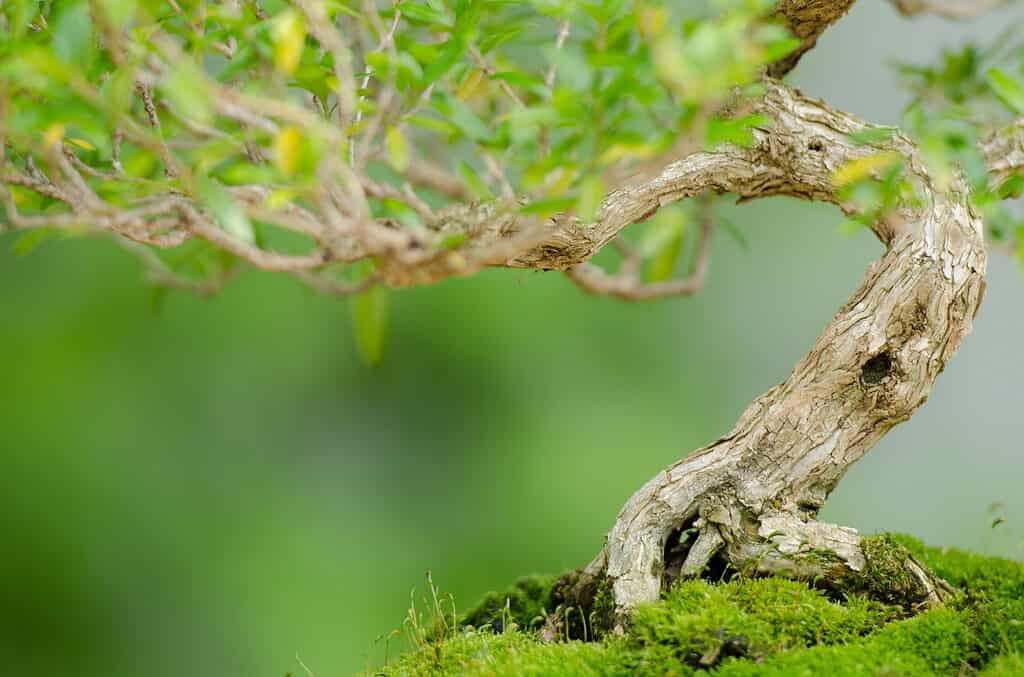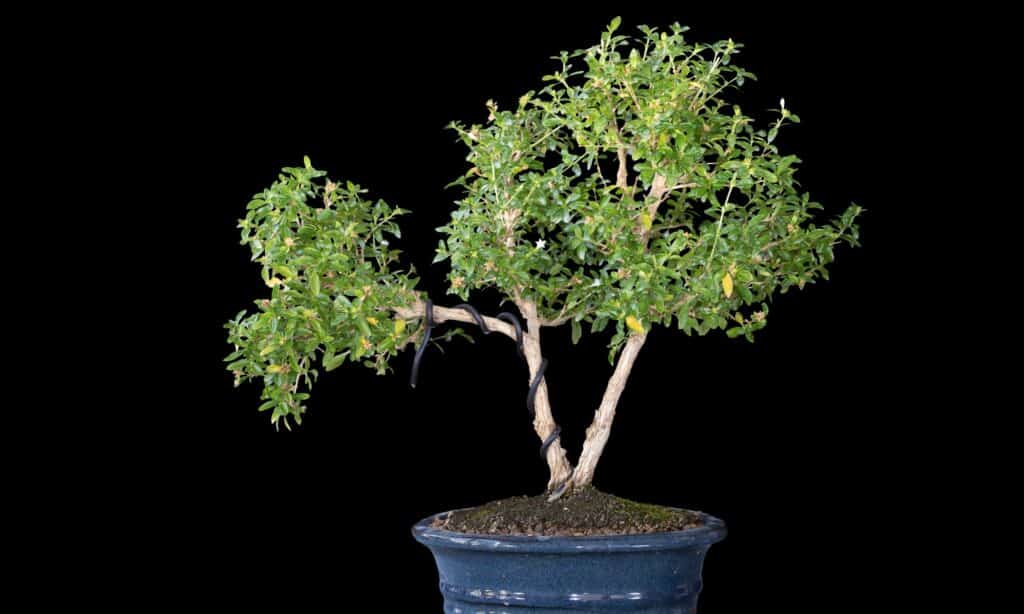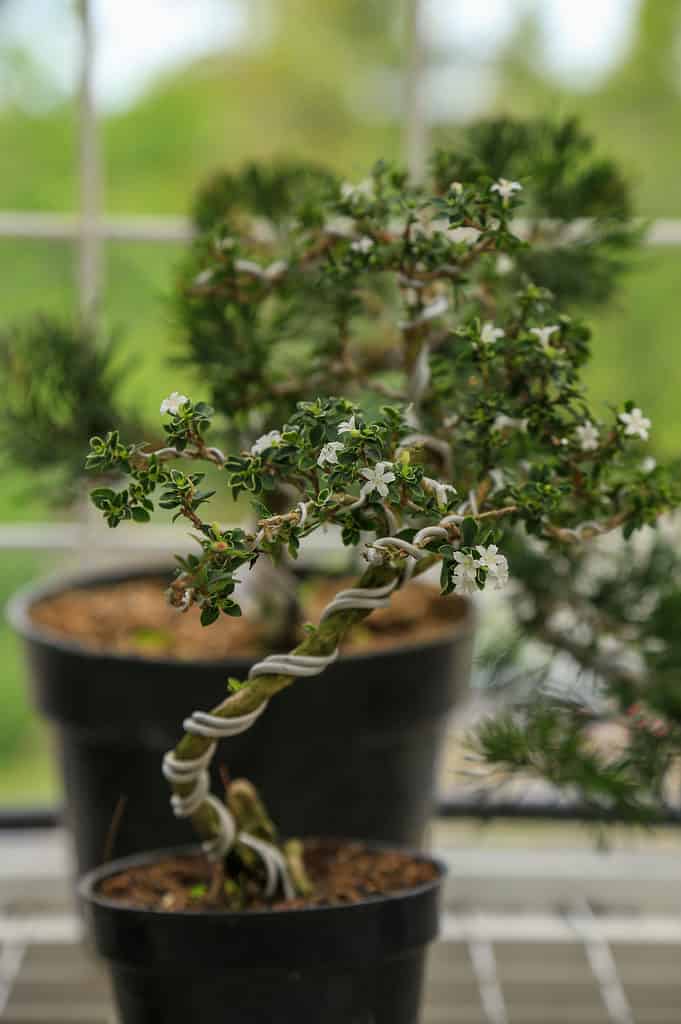Popular for its delicate flowers and intricate bark, the serissa Bonsai tree is not an ideal choice for the beginning Bonsai tree artist. However, this plant is known by a number of names and is still a popular Bonsai tree selection. Feminine and delicate, the serissa Bonsai tree is also known as the snow rose, giving you a hint of what it is like when it is in bloom.
Despite being a bit fussier than other Bonsai trees, the snow rose is a great choice for those of you seeking an indoor and outdoor Bonsai tree choice. But how can you best take care of your serissa Bonsai tree? Here’s a guide that gives you some insight as to everything your new Bonsai tree might need, including some common cultivars. Let’s take a closer look now!

There are a few different names commonly associated with the
serissaplant, including the snow rose and the tree of a thousand stars.
©taviphoto/Shutterstock.com
| Serissa Bonsai Tree | |
|---|---|
| Botanical Name | Serissa japonica, Serissa foetida (formerly) |
| Common Names and Cultivars | Snow rose, tree of a thousand stars, ‘Mt. Fuji’, ‘Variegata’, ‘Kyoto’, ‘Cherry Blossom’ |
| Sunlight | Direct, bright sunlight with temperatures above 50 degrees Fahrenheit |
| Soil | Basic Bonsai tree soil mixture with a monthly fertilizing routine for healthy trees |
| Water | Consistently moist soil is key; never let your snow rose dry out! Misting is appropriate when not in bloom |
| For Beginners? | No; extremely fussy in its care and therefore suited to advanced Bonsai tree cultivators only |
| Indoors or Outdoors? | Both! Outdoors during spring and summer; indoors during fall and winter |
| Pairs Well With… | Aerial root designs, rocks, and moss. Consider a forested scene or let the intricate bark of this tree speak for itself! |
Common Types of Serissa Bonsai Trees

There are a few different cultivars associated with the serissa Bonsai tree, offering you a few different choices when it comes to Bonsai tree cultivation.
©Bernd Schmidt/Shutterstock.com
While currently classified as Serissa japonica, the serissa Bonsai tree was once classified as Serissa foetida. There are a few different names commonly associated with the serissa plant, including the snow rose and the tree of a thousand stars. Additionally, there are a few different cultivars associated with the serissa Bonsai tree, offering you a few different choices when it comes to Bonsai tree cultivation. Here are a few cultivars that you may consider growing instead of a standard Serissa japonica plant.
‘Mt. Fuji’
The average Serissa japonica plant reaches roughly two to four feet tall, and the same can be said for the ‘Mt. Fuji’ cultivar of this plant. However, the leaves and stems of this particular tree grow thicker than the average Serissa japonica cultivar. Depending on care and overall temperature conditions, the leaves and foliage of ‘Mt. Fuji’ serissa Bonsai trees vary in there color. However, the flowers remain white and delicate.
‘Variegata’
As the name suggests, the ‘Variegata’ cultivar of the snow rose Bonsai tree has green leaves with white edges or margins. Variegation in the foliage can vary depending on the health of your specimen, but this particular cultivar is prized for its unique leaves. Full sun is recommended for other cultivars, but you may need to provide this particular serissa plant some shade during extreme temperatures.
‘Cherry Blossom’
If you haven’t already guessed, the ‘Cherry Blossom’ cultivar of the serissa Bonsai tree produces delicate pink flowers throughout the season. ‘Cherry Blossom’ cultivars also have variegated leaves or foliage, depending on the health and wellness of the specimen that you own. There are a few different cultivars that offer you pink flowers, but this is one of the most popular.
‘Kyoto’
Ideal for Bonsai tree cultivation given its compact size, the ‘Kyoto’ snow rose cultivar produces extremely small white flowers. Additionally, the ‘Kyoto’ cultivar only reaches a foot in height on average, making it perfect for Bonsai tree cultivation. The bark on this specimen is still intricate and detailed, a perfect contrast to its small flowers. This option likely won’t need as much pruning either, given its small growth habit!
Caring for Your Serissa Bonsai Tree

Some variegated snow rose cultivars may need protection during the heat of the day, but ample sunshine is key for producing multiple flowers throughout the year.
©Fauzi Tulus Rahmadi/Shutterstock.com
As previously mentioned, the serissa Bonsai tree is not ideal for the beginning Bonsai tree artist. In fact, this type of Bonsai tree makes trouble for experienced cultivators more often than not. With tricky placement needs and a rigorous watering routine, snow rose Bonsai trees are always worth the extra effort. Let’s take a closer look at how to best care for this type of Bonsai tree now.
Sunlight
Sunlight and warmth are key in helping your serissa Bonsai tree thrive. You should place your specimen in full, direct sunlight. Some variegated cultivars may need protection during the heat of the day, but ample sunshine is key for producing multiple flowers throughout the year. Plus, your tree prefers growing temperatures above 50 degrees Fahrenheit, so keep this in mind.
Soil Type
For the most part, any standard Bonsai tree potting soil will work well for a snow rose or Serissa japonica Bonsai tree. However, you should ensure that the mixture is well-draining and of a neutral pH balance. Incorporating stones and clay materials into a soil mixture is a good idea, promoting fast drainage and the perfect amount of water retention.
Water
The watering routine of the average snow rose Bonsai tree is what complicates the overall care of this specimen. Like most Bonsai trees, serissa plants need consistently moist soil, but not too much water. However, this particular Bonsai tree reacts to both over-watering and under-watering much faster than other specimens.
If you notice the leaves falling off of your serissa Bonsai tree, something has likely gone wrong in its watering routine. Adjust with care and try to keep your tree consistently moist, but not drowning. When your specimen is not in bloom, misting it with spray bottles or a plant mister will help keep humidity levels up and your tree happier!

Depending on your climate, you will likely need to bring your serissa Bonsai tree indoors during the fall and winter months, or at the very least, you will need to utilize a greenhouse.
©iStock.com/taviphoto
Placement
It is important to consider the placement of your serissa Bonsai tree carefully, given the fact that this specimen is extremely fickle. Moving your snow rose will likely result in some upset, especially if you do it frequently. Therefore, choose a location that receives plenty of sunlight, both outdoors and in, and leave it alone.
Depending on your climate, you will likely need to bring your serissa Bonsai tree indoors during the fall and winter months, or at the very least, you will need to utilize a greenhouse. Most snow rose specimens will appreciate and survive this particular seasonal movement but try not to move your specimen more than once per year.
Finally, placing your Bonsai tree in a location that doesn’t experience high winds is important. The delicate foliage and flowers of your snow rose tree cannot handle breezy or windy conditions. Plus, wind chill and other wind-related factors can directly affect the overall growth and health of the average Serissa japonica plant.
Pruning Your Serissa Bonsai Tree

Wind chill and other wind-related factors can directly affect the overall growth and health of the average
Serissa japonicaplant.
©hidan.hid/Shutterstock.com
Pruning is another reason why serissa Bonsai trees are not recommended for beginners. It is something that needs to happen after every blooming period in order to encourage more flowers later in the year. Intense pruning should also happen in the springtime, as removing all new branches every couple of years is necessary to keep your snow rose plant small.
As your tree ages, you likely won’t have to prune it as much. However, if it stops producing flowers, pruning in the springtime is necessary. Finally, wiring and shaping your snow rose Bonsai tree is possible throughout the year, but make sure to take your time with the process. The delicate branches adjust well to wiring, but you risk damaging them if you wire them too roughly or for too long. Finding the right balance in all aspects is the main way to keep your serissa Bonsai tree thriving!
Recommended Serissa Bonsai Tree Styles
One of the primary reasons why serissa Bonsai trees are so popular despite their high levels of care is the fact that they style quite well. There are a number of Bonsai tree styles that suit this particular plant, including options that show off its root systems. You can also choose this plant for a forest style of Bonsai tree shape, and a slanting or informal upright style is also popular.
Propagating Your Serissa Bonsai Tree
If you don’t want to purchase an already-established snow rose Bonsai tree, you can easily propagate this option from existing plants. Taking a cutting from a Serissa japonica plant during the springtime is your best bet for a healthy specimen. Make sure to take from the hardwood of the shrub rather than from its new growth. You can also attempt to grow a serissa Bonsai tree from seed, but it takes a long while to cultivate an option in this way.
Common Problems with Serissa Bonsai Trees

The delicate branches of the snow rose Bonsai tree adjust well to wiring, but you risk damaging them if you wire them too roughly or for too long.
©GrooTrai/Shutterstock.com
There are a number of common problems associated with snow rose Bonsai trees, besides their temperamental adjustments to being moved. You may run into problems with watering, especially after you first plant your specimen. Thankfully, it’s easy to tell if your snow rose is suffering from overwatering or underwatering, as the leaves will reflect this quickly. However, root rot is a fairly common issue with this Bonsai tree, so make sure to remove any damaged roots if you notice this occurring.
There are also a number of pests that may plague your serissa Bonsai tree, depending on where you place it. Outdoors, you may run into aphid infestations, while spider mites or other mites may affect your plant indoors. Pesticides and insecticides may help you in this respect but use them with care. Oftentimes, simply increasing the humidity surrounding your serissa Bonsai tree helps combat common pests and overall moisture issues.
All in all, snow rose Bonsai trees are extremely popular specimens, despite their difficulties when it comes to taking care of them. With practice and detailed routines, you can cultivate a serissa Bonsai tree in your own home, enjoying its flowers throughout the year!
The photo featured at the top of this post is © Fauzi Tulus Rahmadi/Shutterstock.com
Thank you for reading! Have some feedback for us? Contact the AZ Animals editorial team.






